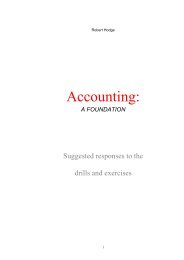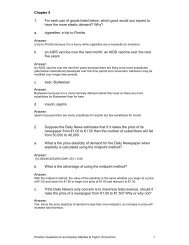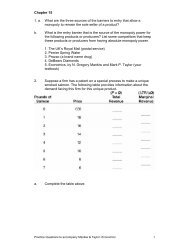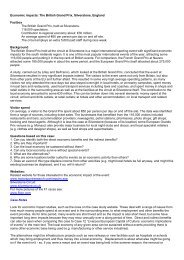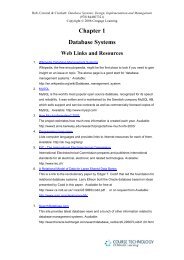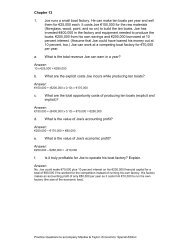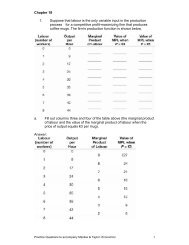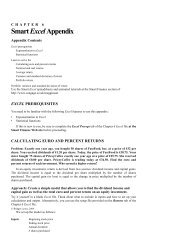Web chaptertwo Hair patterns and designs - Cengage Learning
Web chaptertwo Hair patterns and designs - Cengage Learning
Web chaptertwo Hair patterns and designs - Cengage Learning
You also want an ePaper? Increase the reach of your titles
YUMPU automatically turns print PDFs into web optimized ePapers that Google loves.
4NVQ3 <strong>Hair</strong> <strong>patterns</strong> <strong>and</strong> <strong>designs</strong> AH35RememberDisposal of sharp itemsUsed razor blades <strong>and</strong>similar items should beplaced into a safe container(‘sharps box’). See Chapter 5Disposal of wastes <strong>and</strong> sharps.EKU statementAH35 8) How the positionof your client <strong>and</strong> yourselfcan affect the desiredoutcome <strong>and</strong> reducefatigue <strong>and</strong> the risk of injuryAH35 15) Why it isimportant to position yourcutting tools for ease of use.............................................................................................................................................................................................................................................................................................................Cutting techniquesSee Unit GH16 Creatively cut hair using a combination of cutting techniques.Working position, comfort <strong>and</strong> safetySee Unit GB7 Design <strong>and</strong> create a range of facial shapes pp. 131–132.Working effectively <strong>and</strong> efficientlySee Unit GB7 Design <strong>and</strong> create a range of facial shapes p. 132.EKU AH35 2) Your salon’s expected service times for cutting <strong>patterns</strong> in hairWhat is your salon policy for the use of razors<strong>and</strong> the disposal of sharp items?See Unit GB8 Creatively cut hair using a combination of barbering techniques p. 108 <strong>and</strong>Unit GB7 Design <strong>and</strong> create a range of facial shapes p. 133.EKU AH35 5) Any limitations placed on your use of razors by your local bye-laws <strong>and</strong>legislationEKU statementAH35 14) The correct use<strong>and</strong> maintenance of cuttingtools.Cutting toolsScissors............................................................................................................................................................................................................................................................................................................For more information on scissors, types <strong>and</strong> maintenance see Unit GH16 Creatively cuthair using a combination of techniques pp. 84–85 <strong>and</strong> Unit GB8 creatively barbering.ClippersSee Unit GB7, p. 1 <strong>and</strong> Unit GB8, p. 117.Clipper type Blade profile UsesSt<strong>and</strong>ard clipperWAHL (UK) LTDSt<strong>and</strong>ard width clippers are a general ‘catch-all’ piece of equipment.Available in mains or rechargeable power options, they willcomfortably manage the cutting of large amounts of hair very quickly.They can be fitted with a variety of grade attachments <strong>and</strong> areessential to men’s barbering.T liner/outlinerCOURTESY OF BABYLISS PRO‘T’ liners/outliners are a more specialised clipper that has a T shapedblade. The fixed blade extends beyond the width of the clipper bodyenabling them to be used around the ears or facial hair shapes;providing a closer, (yet safe) cut finish than that of st<strong>and</strong>ard clippers.TramlinerCOURTESY OF BABYLISS PROA tramliner is a specialist narrow blade clipper, designed for intricatelining <strong>and</strong> detailing of hair. These types of clipper enable you to cutfree-form <strong>designs</strong> without inverse etching techniques that you wouldneed to use with the other types of clipper.



